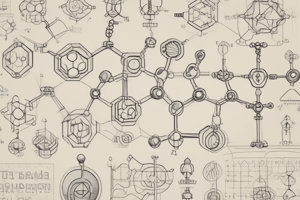Podcast
Questions and Answers
Quina de les següents propietats és típica dels halurs d'alquíl?
Quina de les següents propietats és típica dels halurs d'alquíl?
- Són molt solubles en aigua
- Tenen una fórmula general R-OH
- Són capaços de participar en l'enllaçament d'hidrogen (correct)
- Tenen un punt d'ebullició molt baix
Quin és el nom genèric dels compostos amb fórmula general R-OH?
Quin és el nom genèric dels compostos amb fórmula general R-OH?
- Alcohols (correct)
- Cetones
- Eters
- Aldehids
Quina de les següents afirmacions sobre les cetones és certa?
Quina de les següents afirmacions sobre les cetones és certa?
- Les cetones són més polars que els aldehids
- Les cetones són molt solubles en aigua
- Les cetones són menys polars que els aldehids (correct)
- Les cetones tenen un punt d'ebullició més alt que els aldehids
Quin és el nom del compost amb fórmula general CH3CH2Cl?
Quin és el nom del compost amb fórmula general CH3CH2Cl?
Quina de les següents propietats és comuna a tots els compostos orgànics mencionats?
Quina de les següents propietats és comuna a tots els compostos orgànics mencionats?
Quin dels següents compostos és un èter?
Quin dels següents compostos és un èter?
Flashcards are hidden until you start studying
Study Notes
Alkyl Halides
- Also known as haloalkanes
- General formula: R-X, where R is an alkyl group and X is a halogen (F, Cl, Br, I)
- Classified as primary, secondary, or tertiary based on the number of carbon atoms attached to the carbon bearing the halogen
- Properties:
- Polar and can participate in hydrogen bonding
- Boiling points increase with increasing molecular weight and polarizability of the halogen
- Solubility in water decreases with increasing molecular weight
- Examples: chloroethane (CH3CH2Cl), bromomethane (CH3Br)
Alcohols
- General formula: R-OH
- Classified as primary, secondary, or tertiary based on the number of carbon atoms attached to the carbon bearing the hydroxyl group
- Properties:
- Polar and can participate in hydrogen bonding
- Boiling points increase with increasing molecular weight
- Solubility in water decreases with increasing molecular weight
- Examples: methanol (CH3OH), ethanol (CH3CH2OH)
Ethers
- General formula: R-O-R'
- Properties:
- Less polar than alcohols due to the absence of a hydrogen atom attached to the oxygen
- Lower boiling points than alcohols
- Solubility in water decreases with increasing molecular weight
- Examples: diethyl ether (CH3CH2OCH2CH3), dimethyl ether (CH3OCH3)
Aldehydes
- General formula: R-CHO
- Properties:
- Polar and can participate in hydrogen bonding
- Boiling points increase with increasing molecular weight
- Solubility in water decreases with increasing molecular weight
- Examples: methanal (HCHO), ethanal (CH3CHO)
Ketones
- General formula: R-CO-R'
- Properties:
- Less polar than aldehydes due to the absence of a hydrogen atom attached to the carbon
- Lower boiling points than aldehydes
- Solubility in water decreases with increasing molecular weight
- Examples: propanone (CH3COCH3), butanone (CH3CH2COCH3)
Note: These are general properties and examples, and specific compounds may exhibit different characteristics.
Studying That Suits You
Use AI to generate personalized quizzes and flashcards to suit your learning preferences.




